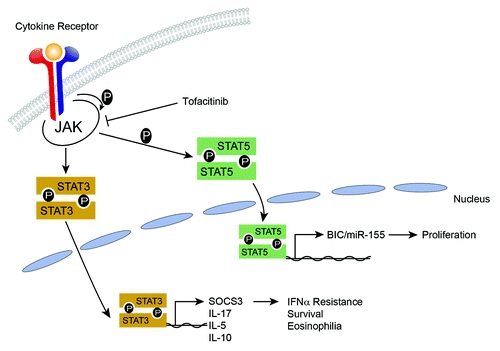Cutaneous T-cell lymphomas (CTCLs) are a group of lymphoproliferative disorders affecting the skin. The etiology of CTCLs is unknown, and the pathogenesis remains elusive.Citation1 Yet CTCL provides an interesting setting for studying the link between inflammation and cancer, since lymphocytic infiltrate is the hallmark of both. Early stages of CTCL mimic benign inflammatory disorders, including psoriasis and eczema, with malignant T cells homing to the skin. This disease usually remains indolent as isolated patches and plaques for many years, but in 10–20% of cases it can progress to form tumors and/or disseminate to lymph nodes, blood and visceral organs.Citation1 Patients with advanced stages of CTCL often succumb to sepsis secondary to breakdown of the skin barrier function and immune suppression. Clinicians specializing in treating this cancer often face a number of important challenges. First, how to diagnose and distinguish early stages of CTCL from other benign inflammatory dermatoses? Second, how to predict which 10–20% of patients are likely to progress toward advanced stages, and, finally, how to achieve a cure of the disease with minimal toxicities? To answer these questions, better understanding of molecular CTCL carcinogenesis is urgently needed, where identified molecular players can be used as novel diagnostic/prognostic markers as well as targets for therapy.
In the article by Kopp et al., the authors establish STAT5-mediated upregulation of mir-155 as an important step in CTCL carcinogenesis.Citation2 Indeed, microRNA (miRNA) studies only recently became a prominent part of CTCL research. Specifically, Ralfkiaer et al. identified a set of miRNA classifiers that can be employed to distinguish early stages of CTCL from other benign inflammatory conditions.Citation3 Still, unfortunately, functional data on miRNA remains sparse and has only begun to emerge in the last few years. miR-155 was recently highlighted as being upregulated in CTCL.Citation3 This gene is a well-studied miRNA that is crucial for inflammation and is often overexpressed in various cancers. In their seminal article Kopp et al. discovered a link between miR-155 expression and JAK/STAT signaling in CTCL.Citation2 They provide evidence that miR-155 is induced via transcription factor STAT5 through either cytokine (IL-2/IL-15)-dependent or constitutive activation in malignant and non-malignant T cells, including PBMCs and primary CTCL cells (). Furthermore, they found miR-155 to be involved in malignant proliferation. Their results are intriguing, because they connect some of the major hallmarks in CTCL: an increased expression of oncomiR-155, deregulation of JAK/STAT signaling pathways, and a persistent activation of STAT transcription factors.Citation2,Citation4
Figure 1. STAT5 signaling trans activates miR-155 expression, which can be blocked upstream at the level of JAK kinase signaling by tofacitinib inhibitor.

While aberrant activation of multiple STAT proteins has been observed in various cancers, until recently, CTCL research has primarily focused on STAT3 as the major culprit in the effects of aberrant JAK/STAT signaling.Citation5 Yet several studies have also implicated STAT5 as being aberrantly activated in malignant T cells. However, little was known about downstream targets and cellular consequences of STAT5 activation in CTCL. Now Kopp et al. document that this well-described oncomiR, miR-155, is a novel downstream target of STAT5 and is involved in malignant proliferation of T cells.Citation2 Since miR-155 has also been implicated in genomic instability in cancer, it is possible that STAT5, via induction of miR-155, also drives genomic instability, a key feature of CTCL.
As mentioned above, one of the major obstacles in managing CTCL is our inability to consistently achieve cure of this cancer. Due to its heterogeneity, there is no common genetic aberration or biomarker providing a reliable therapeutic target for patients. To achieve effective cure, CTCL therapy is in need of new targets and treatment strategies. Kopp et al. showed that treatment of malignant cells with JAK inhibitor tofacitinib (CP 690 550) strongly inhibits miR-155 expression and STAT5 activation. These results suggest a therapeutic potential of JAK inhibitors. Tofacitinib is already clinically approved for treatment of rheumatoid arthritis and is now being tested in clinical trials for psoriasis.Citation6 It would be very interesting to evaluate the potential of tofacitinib in combination with already existing therapies for CTCL. In summary, these combined results hold great potential for diagnosis and treatment of CTCL.
Funding
This work was supported by the Fonds de la recherche en santé du Québec (FRSQ) research grant to Dr. Sasseville, the Canadian Dermatology Foundation Research grant to Dr. Litvinov, Dr. Pehr and Dr. Sasseville.
References
- Talpur R, Singh L, Daulat S, Liu P, Seyfer S, Trynosky T, et al. Long-term outcomes of 1,263 patients with mycosis fungoides and Sézary syndrome from 1982 to 2009. Clin Cancer Res 2012; 18:5051 - 60; http://dx.doi.org/10.1158/1078-0432.CCR-12-0604; PMID: 22850569
- Kopp KL, Ralfkiaer U, Gjerdrum LM, Helvad R, Pedersen IH, Litman T, et al. STAT5-mediated expression of oncogenic miR-155 in cutaneous T-cell lymphoma. Cell Cycle 2013; 12; http://dx.doi.org/10.4161/cc.24987; PMID: 23676217
- Ralfkiaer U, Hagedorn PH, Bangsgaard N, Løvendorf MB, Ahler CB, Svensson L, et al. Diagnostic microRNA profiling in cutaneous T-cell lymphoma (CTCL). Blood 2011; 118:5891 - 900; http://dx.doi.org/10.1182/blood-2011-06-358382; PMID: 21865341
- Litvinov IV, Jones DA, Sasseville D, Kupper TS. Transcriptional profiles predict disease outcome in patients with cutaneous T-cell lymphoma. Clin Cancer Res 2010; 16:2106 - 14; http://dx.doi.org/10.1158/1078-0432.CCR-09-2879; PMID: 20233883
- Abraham RM, Zhang Q, Odum N, Wasik MA. The role of cytokine signaling in the pathogenesis of cutaneous T-cell lymphoma. Cancer Biol Ther 2011; 12:1019 - 22; http://dx.doi.org/10.4161/cbt.12.12.18144; PMID: 22236880
- Scott LJ. Tofacitinib: a review of its use in adult patients with rheumatoid arthritis. Drugs 2013; 73:857 - 74; http://dx.doi.org/10.1007/s40265-013-0065-8; PMID: 23716132